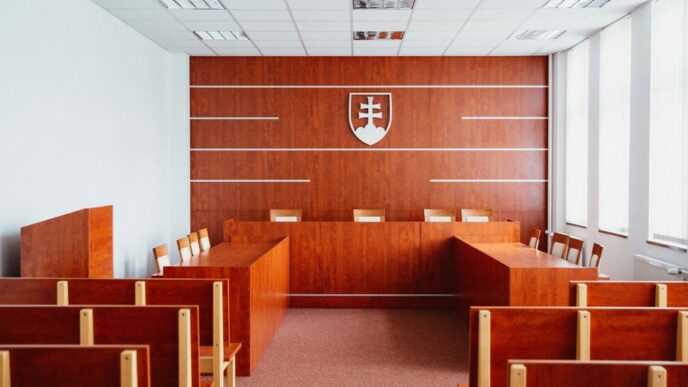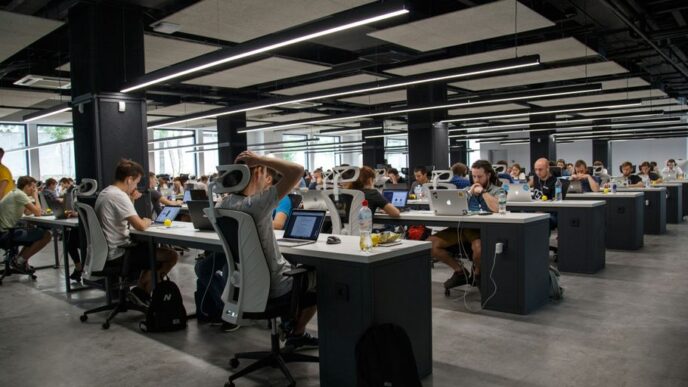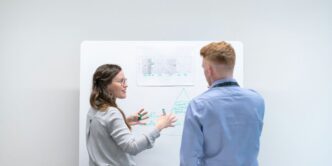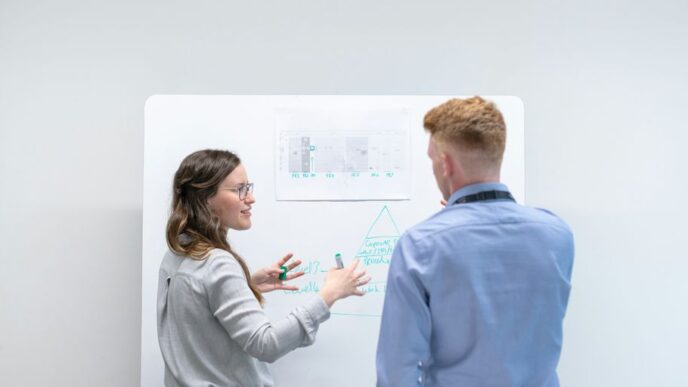Building a team that really works well together is more than just putting people in the same room. It’s about creating an environment where everyone feels safe to speak up, where tasks are clear, and where people can rely on each other. When you get accountability and trust right, teams can do amazing things, often more than any one person could do alone. Let’s look at how to make that happen.
Key Takeaways
- Open communication and transparency are the bedrock for building trust, which in turn makes team members more accountable.
- Clearly defining everyone’s roles and what they’re responsible for prevents confusion and makes sure the team is working towards common goals.
- A team that supports each other and shares responsibility for goals naturally becomes more cohesive and effective.
- Using everyone’s unique skills and allowing for different opinions leads to better ideas and more creative solutions.
- Regular feedback, training, and adjusting how the team works helps it get better over time, boosting overall performance.
Cultivating Trust for Enhanced Accountability
Building a team where people feel safe to speak up and take responsibility really starts with trust. It’s not just about liking each other; it’s about knowing that your teammates have your back and that you can rely on them. When trust is in place, people are more willing to admit mistakes, ask for help, and share their ideas without fear of being shot down. This open environment is where real accountability can grow. Without that foundation of trust, asking for accountability can feel like an accusation, and that’s not good for anyone.
Building Trust Through Open Communication
Open communication is the bedrock of trust. It means creating spaces where everyone feels comfortable sharing their thoughts, concerns, and even their doubts. This isn’t just about talking; it’s about actively listening and making sure everyone feels heard. Regular check-ins, whether in team meetings or one-on-one, can help keep lines of communication clear. It’s also about being upfront about challenges the team is facing, rather than letting problems fester. When people know what’s going on, they can better understand the situation and their role in it. This kind of transparency helps build confidence in the team’s direction and in each other.
The Role of Transparency in Fostering Trust
Transparency means being open about decisions, processes, and even mistakes. When leaders and team members are transparent, it shows that they have nothing to hide. This honesty builds credibility and makes it easier for everyone to trust the information they receive. For example, sharing project updates, even the not-so-great ones, allows the team to adjust and support each other. It’s like knowing the weather forecast; you can prepare for rain instead of being caught off guard. This openness helps prevent misunderstandings and builds a shared understanding of the team’s goals and challenges. It’s a key part of how companies can improve development and achieve goals.
Encouraging Genuineness and Empathy
Being genuine means showing up as your true self at work, and empathy is about understanding and sharing the feelings of others. When team members can be authentic and show empathy, it creates a more human and supportive environment. This means acknowledging that everyone has good days and bad days, and that personal circumstances can sometimes affect work. Showing empathy, like understanding if a teammate is struggling with a personal issue, can strengthen bonds. It encourages people to be more supportive of each other, which in turn makes them more willing to be accountable. When you feel understood and supported, you’re more likely to step up and take ownership.
Establishing Clear Roles and Responsibilities
When everyone on the team knows exactly what they’re supposed to do, things just run smoother. It cuts down on confusion and stops people from accidentally stepping on each other’s toes. Think about it: if two people are working on the same thing because nobody was clear on who owned it, that’s just wasted time and effort, right? We need to make sure each person understands their part in hitting those team goals, and that they have what they need to get it done.
Defining Individual Accountability within the Team
This means laying out who is responsible for what, specifically. It’s not just about assigning tasks, but about making it clear who owns the outcome of those tasks. When you know your specific contribution, you’re more likely to focus and see it through. It helps everyone understand how their work fits into the bigger picture.
Aligning Tasks with Team-Wide Objectives
Once individual roles are clear, we need to connect them to what the whole team is trying to achieve. Every person’s job should directly support the main goals. If someone’s tasks don’t seem to lead anywhere important for the team, it’s worth looking at why. This alignment keeps everyone pulling in the same direction and makes sure our daily work actually moves us closer to our collective targets. It’s like making sure all the players on a sports team know their positions and how they contribute to winning the game.
Preventing Overlap and Wasted Effort
This is where clear roles really shine. When there’s no overlap, we avoid duplicate work. Imagine a project where two people are researching the same topic without knowing it. That’s inefficient. By defining responsibilities clearly, we make sure that each team member is tackling a unique part of the project. This not only saves time but also allows us to cover more ground and utilize everyone’s skills effectively. It’s about making sure we’re all working on the right things, at the right time, without stepping on each other’s toes. For startups, getting this right early on can be a real game-changer, much like getting the business structure sorted out from the beginning.
Fostering a Culture of Shared Accountability
Building a team where everyone feels responsible for the collective outcome is more than just assigning tasks; it’s about creating an environment where people actively want to contribute and support each other. When we talk about shared accountability, we’re really talking about a team dynamic where success and failure are viewed as a group effort, not just individual wins or losses. This kind of atmosphere doesn’t just happen; it needs to be built intentionally.
The Synergy of Mutual Support and Interdependence
Think about it: when team members genuinely support each other, they become more willing to share ideas, take on challenging tasks, and even admit when they’re struggling. This interdependence means we’re not just working alongside each other, but truly relying on each other’s skills and perspectives to get things done. It’s like a well-oiled machine where each part knows its role but also understands how it fits with the others. When people feel this connection, they’re more likely to go the extra mile, not just for themselves, but for the whole team. This mutual reliance is a big part of what makes a team strong. We can see this in action when teams collaborate on projects, like the development of NASA’s Mars Rover, where diverse specialists had to work closely together to achieve a common, complex goal. Building this kind of trust is key to effective collaboration, and it starts with being transparent and valuing honesty. Building trust is the bedrock.
Shared Goals Driving Collective Responsibility
When everyone on the team understands and is committed to the same objectives, it naturally shifts the focus from individual performance to team achievement. It’s about aligning what each person does with the bigger picture. This shared vision makes it easier for people to see how their work contributes to the overall success, and it encourages them to hold themselves and each other accountable for reaching those common targets. When goals are shared, like team-wide OKRs, collaboration becomes more focused, and everyone feels a sense of ownership over the results. This shared purpose is what really drives collective responsibility.
Celebrating Team Successes Together
It’s not just about the hard work; it’s also about acknowledging and celebrating the wins, big or small, as a team. When we celebrate together, it reinforces the idea that we achieved it as a unit. This shared recognition boosts morale, strengthens bonds, and reminds everyone why working together is so rewarding. It’s a way to show appreciation for everyone’s contributions and to build a positive feedback loop that encourages continued collaboration and accountability. Think of it as a team high-five – it feels good, and it makes you want to do it again.
Leveraging Diverse Strengths for Synergy

Think about a sports team. You wouldn’t put five goalies on the field, right? You need a mix of players with different skills – defenders, midfielders, forwards. The same idea applies to any team aiming for real synergy. It’s about recognizing that everyone brings something unique to the table, and when you put those different talents together in the right way, the whole becomes much more than just the sum of its parts. It’s not just about having a variety of people; it’s about how those differences work together.
Harnessing Unique Skills for Innovation
When you have people with different backgrounds and ways of thinking, you get a wider range of ideas. Someone might see a problem from an angle no one else considered. This variety is gold for coming up with new solutions or improving existing processes. It’s like having a toolbox with many different tools; you can tackle a lot more jobs effectively. This is where real innovation happens, not when everyone thinks exactly the same way. It’s about making sure those different skills are actually used and valued. We’ve seen this in action at TeamWave, where different departments collaborate on new features, bringing varied perspectives that lead to better product development.
Encouraging Constructive Disagreement
Now, having different ideas can sometimes lead to disagreements, and that’s okay. In fact, it’s good, as long as it’s handled well. Constructive disagreement means people can voice different opinions or challenge ideas without it becoming personal. It’s about debating the idea, not the person. This kind of discussion helps refine concepts and catch potential issues early on. Without it, you risk groupthink, where everyone just agrees to avoid conflict, and that’s a sure way to stifle creativity and miss out on better options. A team that can disagree productively is a team that’s learning and growing.
Empowering Team Members Through Autonomy
Once you’ve got the right mix of skills and a good way to discuss ideas, the next step is giving people the freedom to use their talents. Autonomy means letting team members have control over how they do their work. When people feel trusted to manage their tasks and make decisions, they tend to be more engaged and creative. It shows you believe in their abilities. This doesn’t mean no guidance, but rather providing the space for individuals to apply their unique strengths without constant micromanagement. It’s about trusting your team to figure out the best way forward, using the skills they have.
Strategies for Continuous Team Development
Keeping a team sharp and ready for whatever comes next is super important. It’s not just about doing the work today, but making sure everyone is growing and the team itself is getting better over time. Think of it like maintaining a car – you can’t just drive it until it breaks down; you need regular check-ups and tune-ups to keep it running smoothly.
Implementing Feedback Loops for Improvement
One of the best ways to keep developing is by setting up ways for people to give and get feedback. This isn’t about pointing fingers; it’s about helping each other get better. Regular check-ins, maybe weekly or bi-weekly, where team members can share what’s working and what’s not, can make a big difference. This open dialogue helps catch small issues before they become big problems. It also gives everyone a chance to learn from each other’s experiences. For instance, a team might use a simple system where after a project, everyone shares one thing they learned and one thing they’d do differently next time. This kind of honest sharing builds trust and makes the whole team smarter.
Investing in Team Training and Workshops
Teams also need to learn new things. This could be anything from learning a new software tool to improving how they communicate. Sending people to workshops or bringing in trainers for specific skills can really pay off. It shows that the company cares about their growth and wants the team to succeed. Sometimes, just a few hours dedicated to learning a new technique can make everyone much more efficient. It’s also a good way to get people thinking outside their usual roles and seeing how they fit into the bigger picture. Think about field service organizations that train their engineers on new product offerings; it directly impacts their ability to serve customers better.
Adapting Team Dynamics for Optimal Performance
Finally, teams aren’t static. People change, projects change, and the world changes. So, the team needs to be able to change too. This means being willing to try new ways of working together. Maybe the current meeting structure isn’t working, or perhaps a new project requires different roles. Being flexible and open to adjusting how the team operates is key. It might involve trying out new collaborative tools or even changing who leads certain meetings. The goal is to always be looking for ways to make the team work better, not just for today, but for the long haul. This continuous adjustment helps keep everyone engaged and ensures the team can handle whatever challenges come its way.
The Impact of Accountability and Trust on Performance

When accountability and trust are in sync, the results for a team can be pretty amazing. It’s not just about getting more done, though that’s a big part of it. Think about it: when people trust each other, they’re more likely to share ideas, even the half-baked ones, without worrying about being shot down. This open sharing really helps with problem-solving and can spark some genuinely new ways of doing things.
Boosting Productivity Through Collaboration
Collaboration isn’t just a buzzword; it’s how teams actually get things done efficiently. When everyone knows what they’re responsible for and trusts their teammates to do their part, the workflow just smooths out. Tasks get distributed based on who’s best at what, and there’s less time wasted figuring out who should do what or redoing work because someone dropped the ball. It’s like a well-oiled machine where each part knows its job and trusts the others to keep things moving. This kind of teamwork can really speed things up and improve the quality of the final product. For instance, teams that work well together often see project completion rates go up, and the work itself is usually better quality. It’s a direct result of people relying on each other and communicating openly, which is what happens when trust is present. Leaders who hold themselves accountable also set a great example for this kind of collaborative spirit [4f8c].
Reducing Burnout and Increasing Engagement
It might seem counterintuitive, but strong accountability and trust can actually reduce burnout. When people feel they can rely on their colleagues and that their contributions are recognized, the pressure feels more manageable. Instead of feeling like they’re carrying the whole load alone, they’re part of a supportive group. This sense of belonging and shared responsibility makes work feel less like a solo struggle and more like a team effort. Plus, when people are engaged and feel trusted, they’re generally happier and more satisfied with their jobs. This often means they stick around longer, too, which is a win-win for everyone involved.
Achieving Outcomes Greater Than Individual Efforts
This is where the real magic happens. When you combine individual skills with a foundation of trust and clear accountability, the team can achieve things that no single person could do on their own. It’s about synergy – the idea that the whole is greater than the sum of its parts. Teams that have this dynamic often come up with more innovative solutions, handle complex problems more effectively, and ultimately produce results that exceed expectations. They’re not just completing tasks; they’re creating something bigger and better together. This collective success builds momentum and reinforces the positive cycle of trust and accountability, making the team even stronger for the next challenge.
Bringing It All Together
So, we’ve talked a lot about how trust and accountability are like the two sides of the same coin when it comes to building a solid team. You can’t really have one without the other working well. When people trust each other, they’re more likely to be open, share ideas, and admit when they mess up, which is where accountability comes in. And when everyone knows they can count on each other to do their part and own their mistakes, that trust just grows. It’s not always easy, and it takes some real effort, maybe trying out some new ways to connect or just being more upfront with each other. But when you get it right, your team just clicks. Things get done smoother, people feel better about coming to work, and you end up with something pretty great – a team that actually works well together.
Frequently Asked Questions
What exactly is team synergy?
Think of team synergy like a well-oiled machine. When everyone on the team works together smoothly, sharing ideas and helping each other out, they can get way more done and come up with cooler ideas than if they all worked alone. It’s like everyone’s powers combined!
How do I build trust with my teammates?
Building trust is super important! You can do this by talking openly with your teammates, being honest about what you’re doing, and showing you care about them. Little things like grabbing lunch together or just checking in can make a big difference.
Why is it important to have clear roles on a team?
When everyone knows what their job is and what they’re responsible for, things run much smoother. It’s like having a clear map for a project. This stops people from doing the same work or important tasks being missed.
How does working towards shared goals help a team?
When a team works together towards the same goals, everyone feels responsible for reaching them. It’s like being on a sports team where everyone wants to win. Celebrating wins together also makes everyone feel good and more connected.
How do different skills on a team create better results?
Everyone has their own special talents! When a team uses everyone’s unique skills, they can come up with more creative ideas and solve problems in different ways. It’s okay to disagree sometimes, as long as it’s done respectfully to make the final idea even better.
How can teams keep getting better?
Teams get better over time by learning from what worked and what didn’t. Getting feedback from each other, learning new skills through training, and being open to changing how the team works helps everyone perform at their best.













